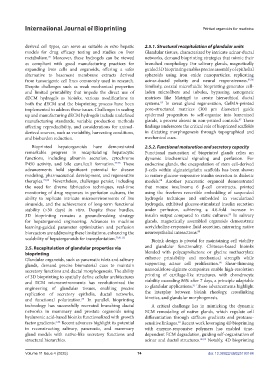Page 82 - v11i4
P. 82
International Journal of Bioprinting Printed organoids for medicine
derived cell types, can serve as suitable in vitro hepatic 2.5.1. Structural recapitulation of glandular units
models for drug efficacy testing and studies on liver Glandular tissues, characterized by intricate acinar-ductal
metabolism. Moreover, these hydrogels can be viewed networks, demand bioprinting strategies that mimic their
76
as compliant with good manufacturing practices for branched morphology. For salivary glands, magnetically
expanding liver cells and organoids, offering a safer guided 3D bioprinting enables precise assembly of epithelial
alternative to basement membrane extracts derived spheroids using iron oxide nanoparticles, replicating
from tumorigenic cell lines commonly used in research. acinar-ductal polarity and neural responsiveness. 85,86
Despite challenges such as weak mechanical properties Similarly, coaxial microfluidic bioprinting generates cell-
and limited printability that impede the direct use of laden microfibers and tubules, bypassing xenogeneic
dECM hydrogels as bioinks, various modifications to matrices like Matrigel to create hierarchical ductal
85
both the dECM and the bioprinting process have been systems. In sweat gland regeneration, GelMA-printed
implemented to address these issues. Challenges in scaling pore-structured matrices (300 µm diameter) guide
up and manufacturing dECM hydrogels include undefined epidermal progenitors to self-organize into lumenized
87
manufacturing standards, variable production methods glands, a process absent in non-printed controls. These
affecting reproducibility, and considerations for animal- findings underscore the critical role of bioprinted scaffolds
derived sources, such as variability, harvesting conditions, in dictating morphogenesis through topographical and
and bioburden reduction. mechanical cues.
Bioprinted hepatorganoids have demonstrated 2.5.2. Functional maturation and secretory capacity
remarkable progress in recapitulating hepatocytic Functional maturation of bioprinted glands relies on
functions, including albumin secretion, cytochrome dynamic biochemical signaling and perfusion. For
P450 activity, and bile canaliculi formation. 77,78 These endocrine glands, the encapsulation of stem cell-derived
advancements hold significant potential for disease β-cells within alginate/gelatin scaffolds has been shown
modeling, pharmaceutical development, and regenerative to restore glucose-responsive insulin secretion in diabetic
therapies. 79,80 Nevertheless, challenges persist, including models. Another pancreatic organoid demonstrated
88
the need for diverse fabrication techniques, real-time that mouse insulinoma 6 β-cell constructs, printed
monitoring of drug responses in perfusion cultures, the using the freeform reversible embedding of suspended
ability to replicate intricate microenvironments of live hydrogels technique and embedded in vascularized
sinusoids, and the achievement of long-term functional hydrogels, exhibited glucose-stimulated insulin secretion
stability (>30 days) in vitro. Despite these hurdles, under perfusion, achieving a 4.6-fold increase in
3D bioprinting remains a groundbreaking strategy insulin output compared to static cultures. In salivary
89
for hepatorganoid engineering. Advances in machine glands, magnetically assembled organoids demonstrate
learning-guided parameter optimization and perfusion acetylcholine-responsive fluid secretion, mirroring native
85
bioreactors are addressing these limitations, enhancing the neuroepithelial interactions.
scalability of hepatorganoids for transplantation. 78,81,82 Bioink design is pivotal for maintaining cell viability
2.5. Recapitulation of glandular properties via and glandular functionality. Chitosan-based bioinks
bioprinting blended with polycaprolactone or glycine methacrylate
Glandular organoids, such as pancreatic islets and salivary enhance printability and mechanical strength while
90
glands, demand precise biomaterial cues to maintain supporting acinar cell proliferation. Shear-thinning
secretory functions and ductal morphogenesis. The ability nanocellulose-alginate composites enable high-resolution
of 3D bioprinting to spatially define cellular architectures printing of cartilage-like structures, with chondrocyte
and ECM microenvironments has revolutionized the viability exceeding 86% after 7 days, a principle adaptable
91
engineering of glandular tissues, enabling precise to glandular applications. These advancements highlight
replication of secretory epithelia, ductal networks, the interplay between bioink rheology, crosslinking
83
and functional polarization. In parallel, bioprinting kinetics, and glandular morphogenesis.
technology has successfully recreated branching ductal A critical challenge lies in mimicking the dynamic
networks in mammary and prostate organoids using ECM remodeling of native glands, which regulate cell
hyaluronic acid-based bioinks functionalized with growth differentiation through stiffness gradients and protease-
factor gradients. Recent advances highlight its potential sensitive linkages. Recent work leveraging 4D bioprinting
6,84
92
in reconstructing salivary, pancreatic, and mammary with enzyme-responsive polymers has enabled time-
gland models with native-like secretory functions and dependent ECM degradation, guiding self-organization of
structural hierarchies. acinar and ductal structures. 46,93 Notably, 4D bioprinting
Volume 11 Issue 4 (2025) 74 doi: 10.36922/IJB025190184

